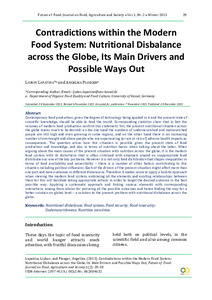| dc.date.accessioned | 2014-02-11T12:21:34Z | |
| dc.date.available | 2014-02-11T12:21:34Z | |
| dc.date.issued | 2013-12-20 | |
| dc.identifier.issn | 2197-411X | |
| dc.identifier.uri | urn:nbn:de:hebis:34-2014021145060 | |
| dc.identifier.uri | http://hdl.handle.net/123456789/2014021145060 | |
| dc.language.iso | eng | |
| dc.publisher | Department of Organic Food Quality and Food Culture at the University of Kassel, Germany and Federation of German Scientists (VDW) | eng |
| dc.rights | Urheberrechtlich geschützt | |
| dc.rights.uri | https://rightsstatements.org/page/InC/1.0/ | |
| dc.subject | Nutritional disbalance | eng |
| dc.subject | Food system | eng |
| dc.subject | Food security | eng |
| dc.subject | Food insecurity | eng |
| dc.subject | Undernourishment | eng |
| dc.subject | Nutrition transition | eng |
| dc.subject.ddc | 630 | |
| dc.title | Contradictions within the Modern Food System: Nutritional Disbalance across the Globe, Its Main Drivers and Possible Ways Out | eng |
| dc.type | Aufsatz | |
| dcterms.abstract | Contemporary food production, given the degree of technology being applied in it and the present state of scientific knowledge, should be able to feed the world. Corresponding statistics show that in fact the volumes of modern food production confirm this statement. Yet, the present nutritional situation across the globe leaves much to be desired: on the one hand the numbers of undernourished and malnourished people are still high and even growing in some regions, and on the other hand there is an increasing number of overweight and obese people who are experiencing (or are at risk of) adverse health impacts as consequences. The question arises how this situation is possible given the present state of food production and knowledge, and also in terms of nutrition basics when talking about the latter. When arguing about the main causes of the present situation with nutrition across the globe, it is the modern food system with its distortions that is often criticised with emphasis placed on inappropriate food distribution as one of the key problems. However it is not only food distribution that shapes inequalities in terms of food availability and accessibility – there is a number of other factors contributing to this situation including political influences. Each of the drivers of the present situation might affect more than one part and have outcomes in different dimensions. Therefore it makes sense to apply a holistic approach when viewing the modern food system, embracing all the elements and existing relationships between them for this will facilitate taking appropriate actions in order to target the desired outcome in the best possible way. Applying a systematic approach and linking various elements with corresponding interactions among them allows for picturing all the possible outcomes and hence finding the way for a better solution on global level – a solution to the present problem with nutritional disbalance across the globe. | eng |
| dcterms.accessRights | open access | |
| dcterms.bibliographicCitation | In: Future of Food: Journal on Food, Agriculture and Society. Witzenhausen : University of Kassel, Department of Organic Food Quality and Food Culture. - Vol. 1, No. 2 (2013), S. 29-38 | |
| dcterms.creator | Lapatina, Liubov | |
| dcterms.creator | Ploeger, Angelika | |

